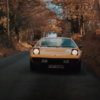The Lamborghini Huracan is one of the most powerful and highest-performing supercars in the world. But what about its fuel economy? How much gas mileage can you expect from this powerhouse on the road? Read on to find out more about the Lamborghini Huracan’s MPG & Gas Mileage Data.
What is the MPG & Fuel Economy of a Lamborghini Huracan?
The fuel economy of all Lamborghini Huracan models varies significantly depending on the model and trim. Generally, the fuel economy is around 11-17 mpg city and 16-27 mpg highway.
- Huracán LP 610-4 Coupé: MPG – 13 city / 20 highway. Fuel Economy – 13.2L/100km
- Huracán LP 610-4 Spyder: MPG – 13 city / 19 highway. Fuel Economy – 13.5L/100km
- Huracán LP 580-2: MPG – 14 city / 20 highway. Fuel Economy – 12.6L/100km
- Huracán LP 580-2 Spyder: MPG – 13 city / 19 highway. Fuel Economy – 13.5L/100km
- Huracán LP 640-4 Performante: MPG – 13 city / 19 highway. Fuel Economy – 13.2L/100km
- Huracán LP 640-4 Performante Spyder: MPG – 13 city / 19 highway. Fuel Economy – 13.5L/100km
- Huracán Evo: MPG – 14 city / 20 highway. Fuel Economy – 12.6L/100km
- Huracán Evo Spyder: MPG – 13 city / 19 highway. Fuel Economy – 13.5L/100km
- Huracán Evo RWD: MPG – 14 city / 20 highway. Fuel Economy – 12.6L/100km
- Huracán Evo RWD Spyder: MPG – 13 city / 19 highway. Fuel Economy – 13.5L/100km
- Huracán STO: MPG – 14 city / 20 highway. Fuel Economy – 12.6L/100km
- Huracán Tecnica: MPG – 14 city / 20 highway. Fuel Economy – 12.6L/100km
- Huracán Sterrato: MPG – 14 city / 20 highway. Fuel Economy – 12.6L/100km
Lamborghini Huracán Fuel Tank Capacity
The fuel tank capacity of the Lamborghini Huracán varies depending on the specific model and year of the car. Here are the fuel tank capacities for a few different models of the Lamborghini Huracán:
- Lamborghini Huracán LP 610-4 (2014-2019): 83 liters (21.9 US gallons)
- Lamborghini Huracán LP 580-2 (2016-2019): 80 liters (21.1 US gallons)
- Lamborghini Huracán EVO (2019-present): 83 liters (21.9 US gallons)
- Lamborghini Huracán Performante (2018-2019): 83 liters (21.9 US gallons)
- Lamborghini Huracán STO (2020-present): 75 liters (19.8 US gallons)
- Lamborghini Huracán Tecnica (2022-present): 80 liters (21.13 US gallons)
It’s worth noting that fuel tank capacities may vary slightly between different regions and countries due to differences in measurement systems.
What gas does a Lamborghini Huracan take?
The Lamborghini Huracán is designed to run on premium unleaded gasoline with an octane rating of 98 or higher. This is typically referred to as “super” or “super plus” gasoline in different regions of the world.
Using gasoline with an octane rating that is too low can cause engine knocking and potentially damage the engine, which is why Lamborghini and other high-performance car manufacturers recommend using high-octane gasoline.
It’s important to note that using gasoline with a higher octane rating than what is recommended by the manufacturer will not provide any additional performance benefits and may even be less efficient in terms of fuel economy. Therefore, it’s generally recommended to use the specific octane rating recommended by the manufacturer.
How does the Huracan compare to other supercars in terms of MPG and gas mileage data?
In general, supercars like the Lamborghini Huracán are not known for their fuel efficiency, and this is due to several factors such as their high-performance engines, heavy curb weights, and aerodynamic designs that prioritize speed over fuel economy.
According to the EPA, the 2021 Lamborghini Huracán EVO coupe and Spyder models have a combined fuel economy rating of 14 miles per gallon (mpg) with 11 mpg in the city and 18 mpg on the highway. The more powerful Lamborghini Huracán Performante, on the other hand, has a combined fuel economy rating of 13 mpg with 11 mpg in the city and 17 mpg on the highway.
Compared to other supercars, the fuel economy of the Lamborghini Huracán is generally in line with what you might expect. For example, the 2021 Ferrari F8 Tributo has a combined fuel economy rating of 15 mpg, while the 2021 Porsche 911 GT3 has a combined rating of 16 mpg.
| Car Model | MPG (city/highway/combined) |
| Lamborghini Huracan | 13/18/15 |
| Ferrari 488 GTB | 15/22/18 |
| McLaren 720S | 15/22/18 |
| Porsche 911 Turbo S | 15/20/17 |
| Audi R8 V10 Plus | 13/20/16 |
| Acura NSX | 21/22/21 |
It’s worth noting that fuel economy ratings for supercars are often less important to buyers than other factors such as acceleration, top speed, and overall performance.
How Much Will a Lamborghini Huracan Cost to Fill Up With Gasoline?
The Lamborghini Huracan has an estimated fuel economy rating of 13 miles per gallon in the city and 19 miles per gallon on the highway. Assuming the Huracan has a 21-gallon gas tank, it would cost approximately $115 to fill up with gasoline at the current national average of $2.52 per gallon.
What factors influence the Lamborghini Huracan’s MPG and gas mileage data figures?
The fuel economy of the Lamborghini Huracán is influenced by a variety of factors, including:
- Engine size and power: The Lamborghini Huracán is equipped with a high-performance engine that is designed to deliver maximum power and acceleration. However, this also means that the engine consumes more fuel, which can reduce the car’s fuel economy.
- Aerodynamics: Huracán’s aerodynamic design is optimized for high-speed driving and cornering, which can reduce fuel efficiency. The car’s low ground clearance and aggressive bodywork can also increase wind resistance, which can cause the engine to work harder and consume more fuel.
- Weight: The Huracán is a relatively heavy car, weighing around 3,300 pounds. This means that the engine has to work harder to move the car, which can result in lower fuel economy.
- Driving style: Aggressive driving, frequent acceleration, and high-speed driving can all reduce fuel economy. On the other hand, a more conservative driving style that avoids rapid acceleration and maintains a steady speed can improve fuel efficiency.
- Environmental conditions: Environmental factors such as temperature, humidity, and altitude can also affect a car’s fuel economy. For example, driving in very cold temperatures can cause the engine to work harder to maintain optimal operating temperatures, which can reduce fuel efficiency. Similarly, driving at high altitudes can reduce air density and engine performance, which can reduce fuel economy.
Conclusion
Driving a Lamborghini Huracan offers excellent performance combined with impressive MPG & Fuel Economy data. However, these figures can be further improved with regular maintenance and following manufacturer-recommended driving habits. It’s also important to be aware of the vehicle’s environmental impact and do your best to reduce it when possible.



